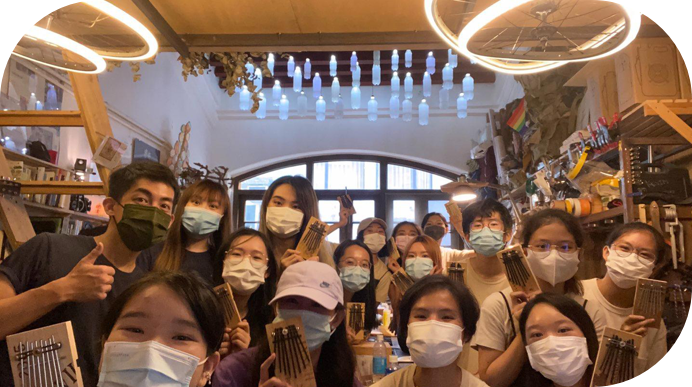现时全球温度已
上升了摄氏1.1至1.2度
,若能把温度升幅限制于
摄氏1.5度內
,人类仍能把握最后机会挽救地球
化石燃料 成就了人类现代生活和文明,但它既是福,也是祸。化石燃料提供方便廉价的能源,促成超乎想像的科技、社会及经济发展。在进步与现代建设的繁华背后,燃烧煤、石油和天然气的过程中释出二氧化碳和其他温室气体,造成环境污染,依赖化石燃料更启动了气候变化的恶性循环,酿成全球增温、旱灾、水灾及极端天气等问题。与前工业化时期相比,现时全球温度已上升了摄氏1.1至1.2度,若能把温度升幅限制于摄氏1.5度内,人类仍能把握最后机会挽救地球,此为2015年多国于巴黎订立的环保目标,并在去年于格拉斯哥气候峰会上首次确认其可行性。然而,把全球温度升幅限制于摄氏1.5度内,意味着人类需要在本世纪中叶前,完全终止由工业、农业及伐林过程所产生的化石燃料碳排放。
有见及此,香港政府跟世界各地政府一样,承诺于2050年达至「碳中和」,同时设立多项中期目标,以确保减碳进度良好。跟所有气候相关词汇一样, 「碳中和」的意思需细细解释:「碳」在元素周期表中排行第六,是人类、动植物和土壤的组成部件,但「碳中和」中的「碳」指的是主要温室气体二氧化碳,亦可扩大至所有温室气体,例如由畜牧及钻油活动产生的甲烷;「中和」则表示人类几乎没有排放任何温室气体,方法包括减少排放、透过植树和保育自然生态移除空气中的温室气体,或投资和参与减排活动以抵销排放等。


香港中文大学深明气候危机乃当务之急,补救行动刻不容缓,故订立目标于2038年前实现校园碳中和。鉴于二氧化碳可停留在大气中约一百年,我们必须赶及于2050年前达至碳中和,才能确保地球的温度升幅能保持在摄氏1.5度这条警界线内。在2020至21年度,大学排放了39,494公吨碳当量,较上年度下降了26.7%,跌幅或与因应疫情而停止面授课堂有关,但仍然值得鼓舞,我们将持之以恒,且有信心实现减碳目标。事实上,中大多年来已推行不少减碳策略,例如「绿色办公室计划」、2014年起推行的「节约能源奖励计划」及2020年起推行的「能源效益资助计划」,在节约用电及减少碳排放方面均取得显著成效。
中大是香港校园面积最大的高等学府,校园依山而建,坐拥吐露港胜景,也是许多动植物的栖息地。中大员生极为珍视这片冠绝香港的优美校园,积极参与保育环境的工作。每天,中大自然环境都散发着可持续发展的气息,中大员生非常乐意宣扬绿色生活的重要性,从爱护动物到自备水壸及餐具,以至建立步行习惯取代乘搭校巴,都是要为环保出一分力。中大「可持续发展目标行动资助计划」鼓励热衷环保的员生发挥创意,资助他们透过新颖而有意义的方式推动联合国可持续发展目标,活动形式层出不穷,包括探索街市的可行减塑锦囊,举办各式各样的升级再造工作坊,以及推广结合「捡垃圾」(picking up litter)和「慢跑」(jogging)的新兴活动「环保慢跑」(plogging)。中大关注可持续发展,我们定当在各个运作范畴施行环保策略,期望从大学出发,推动大众作出态度及行为上的转变。我们乐于与公众携手合作,解决气候危机,拯救濒危的地球。

赛马会气候变化博物馆的气候教育
中大学生社创团队180DC@CUHK为同学举办升级再造工作坊

由现在起到2038年,我们可如何达至碳中和?首先,必须减少使用化石燃料。中大陆续引入电动车,增设电动车充电设施,更扩大可再生能源的应用,安装太阳能发电系统。中大建筑物的设计符合环保原则,采用自然光及自然通风,加上大学致力完善贯穿校园的步行设施,都有助减低能源消耗,鼓励大学员生及访客养成低碳生活的习惯。此外,我们于建筑物外围栽种植物及绿化天台,植物能吸收及储存二氧化碳,亦帮助降温。我们亦会继续推广绿色办公室措施,进一步减少排放,提升能源效益。我们近期委托了顾问公司,制定中大实现碳中和的路线图。赛马会气候变化博物馆及联合国可持续发展解决方案网络香港地区分会(「SDSN香港」)亦将全力支持大学的气候行动。
针对源头停止污染是达至净零碳排最有效的方法,可惜的是,这并非经常可行。中大在履行使命时,各式作业造成的碳排放乃无可避免,我们决心以其他方法弥补,例如以植树来增加碳吸收,及实施更多行之有效且富有意义的除碳策略。大自然赠予人类无价之宝,不问回报。我们是时候对自然致敬,回馈万物。
李凯琪为香港中文大学传讯及公共关系处编辑
下一篇
未来在你我手中



